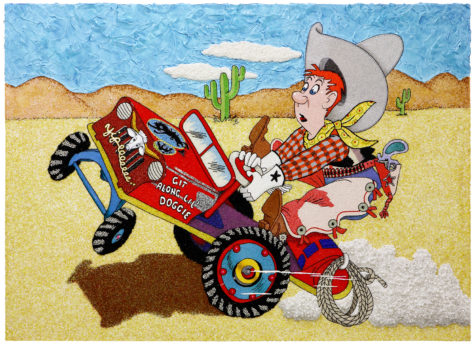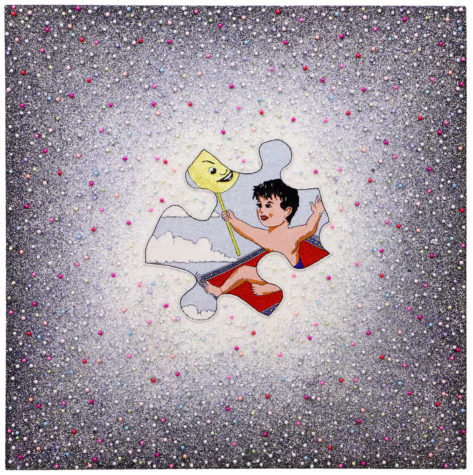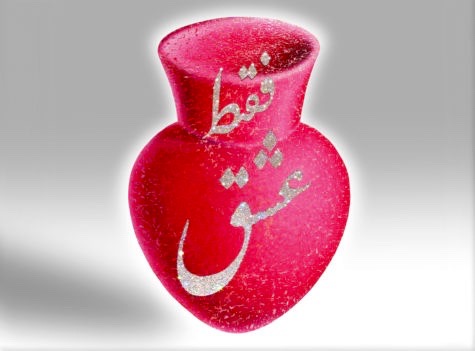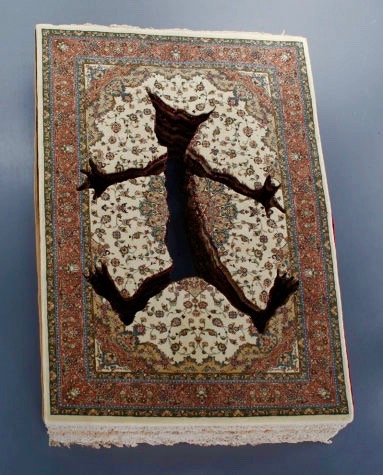Pop Art in Dreamland: Moshiri’s ‘Go West’ Show at The Warhol

Now here’s an uneasy rider. Does your life feel like this? Does your society? The piece is ‘Yipeeee!’ (2009) by Farhad Moshiri. (See image credits at the end.)
Don’t know about you, but I like art that I can get into on multiple levels. Case in point: the special exhibit Go West (through January 14) at the Andy Warhol Museum. For anyone with an interest in pop art or cross-cultural trends in art, the show offers fascinating examples of what’s possible by combining various elements and influences. And for anyone who enjoys good art, period, it’s definitely that.
Go West features the work of Farhad Moshiri, an Iranian artist. He has described his art as “second-generation pop” and he’s been called “the Andy Warhol of the Middle East.” Moshiri, 54, went West himself once, moving to California with his parents as a teenager and then earning an MFA at California Institute of the Arts. After returning to Tehran in 1991 he struggled for a while, then became a late-midlife sensation. The pieces in Go West are a mesmerizing mixture of the bizarre and the beautiful.
Drawing a Bead on the Cowboy
Right at the show’s entrance is “Yipeeee!” (photo above). This cowboy cartoon has ties to classic U.S. pop in that the image comes straight from a mass-market source, like Warhol’s early paintings of soup cans. The source for “Yipeeee!” was a metal wind-up toy called Rodeo Joe made in the U.S. during the 1930s. In fact, the toy cowboy on a bucking motor vehicle is displayed next to Moshiri’s piece, along with the box it came in. “Yipeeee!” is a near replica of the illustration on the box.
But Moshiri did more than enlarge the picture to gallery-art size. He literally got it to shine. Only some parts of “Yipeeee!” are painted. Most of it is a giant beaded embroidery, made with zillions of tiny colored beads stitched onto the canvas. Elaborate embroidery is a traditional craft in the Middle East, still popular today. The artist hired expert craftswomen for the handwork on this piece and others in the show. So “Yipeeee!” is East-West fusion pop—and the fusion is brilliant.
The photos in this review don’t capture the power of the actual art on the walls. When a friend and I visited Go West, we spent a long time just marveling at “Yipeeee!” The impeccable virtuosity of the glittery beadwork somehow goes oh, so rightly with the loose-goose wackiness of the picture, while the picture invites weird speculation. Why depict a cumbersomely equipped cowpuncher on an out-of-control machine? Is it a metaphor for how our highly mechanized Western society is getting away from us, or—as we say in Pittsburgh, or what? At any rate, “Yipeeee!” alone is worth a look, and there’s more inside the exhibit.
A Gallery of Dreamworks

Moshiri’s ‘Self-Portrait on Flying Carpet’ (2009) is a dream, in every sense.
The gallery housing the rest of Go West is not a wide-open space. It’s laid out to channel you around a circuit, in corridors that keep you close to the art. This fits with the spirit of the show: It induces the sensation of entering a dreamlike maze, in which a number of the pieces speak (or at least, speak to me) with emotional closeness.
One is “Self-Portrait on Flying Carpet.” This too is done in paint and embroidered beads, with bigger beads added to create a 3-D, sailing-through-the-galaxy effect. Fans of multiculturalism in art will also note the mixing of cultural signifiers in the juxtaposition of the Persian flying carpet and the yellow smiley face. But I say, screw the polysyllabic scholarly words and just dig the thing. The “Self-Portrait” is childlike, and maybe (like me) you don’t normally go for childlike art. I was surprised at how easily the piece seeped through that barrier to evoke thoughts and feelings I’d forgotten I had.
And speaking of childish things, the piece next to it takes the cake a dimension further. “Friends Forever” is a beaded pastiche of cutesy cartoon imagery: a perky little bunny, a smiling snowman, a jaunty hummingbird snorkeling nectar out of a blossom, a little boy releasing a songbird from a cage. Among the cheery chimes of childhood, however, sinister notes intrude. The snowman’s carrot nose is suspiciously phallic. In one corner of the piece, a boy reaches tentatively to pluck an apple from a tree—didn’t somebody say not to touch the apples?—and smack in the center is a rendering of the old cliché “a bird in the hand.” It shows an adult-sized hand grasping and nearly squashing the creature.
You may wish to bring a developmental psychologist to help you interpret “Friends Forever.” Or, again, just dig it. The images will probably stay in my head forever.
Other favorites? A few too many to mention, though two stand out. Moshiri’s “Self-Portrait Under Water” has the artist on the sea floor in a Jules Verne-ish diving suit, painting a canvas while curious fishies look on. And “Splash”—a beaded embroidery in black and ivory—is a striking picture of an incident on the wave-tossed surface of a sea.
The central figure in “Splash,” utterly adult in form and mood, is an exotic-looking woman with a noble visage like those on Grecian urns or in old Persian miniature paintings. In keeping with Middle Eastern modesty, she wears an early 1900s-style swimsuit. And she is borne aloft, clear of the roiling waves, by a mysterious pair of hands and arms that emerge from the waves as if belonging to a sea-god, seizing her from behind. Viewers familiar with American pop art might find here a sly counter-reference to Roy Lichtenstein’s iconic “Drowning Girl.” That’s cool, though “Splash” on its own is more than enough for the mind and eye: a picture with mythical, dream-world overtones.
Famous Jars and Cultural Commentary

‘Faghat Eshgh (Only Love),’ from 2007, dazzles the eyeballs.
One part of the Go West exhibit has a selection of Moshiri’s jar paintings. Another traditional craft in Iran is the making of ceramics, including decorative jars which over the years have been used for foods and drinks, or simply as vases or whatnot. When Moshiri was building his career he’d look for 19th-century jars that caught his eye and paint their likenesses, often superimposing messages in Farsi script: the one shown here says “Only Love.”
You could, I suppose, think of these pieces as a vintage Iranian equivalent of Andy’s soup cans. They have sold well on the booming markets for Middle Eastern art. The region has plenty of wealthy collectors; there’s a hot gallery scene in Dubai—and, the jar pictures are fun to look at. They’re big and colorful. The paint surfaces are layered and (intentionally) crinkled in ways that make them hypnotically entrancing. Yet for me, they didn’t strike any deeper chords beyond the visual thrills—perhaps because to me, a Westerner, they’re only jars.
Finally, the show includes several works of art that make explicit socio-cultural statements. It would be hard for any Westerner to avoid reacting to them in some fashion, because they are bold pieces that leave no room for wiggle. Again we’ll take two examples.
At the front of the gallery is a sort of companion to “Yipeeee!” titled “America.” Like America, it is huge, and similar to “Splash” it’s a monochrome beaded embroidery, black on silvery beige. The scene is an old-West saloon filled with gunfights, fistfights, tough guys chasing each other around the card table and the billiards table, swinging from the chandelier, and so forth, while a piano player tinkles away despite the chaos … You get the picture. “America.”

A crazy American cat penetrates Persian carpets in ‘Crash’ (2011).
And off in a corner is “Crash.” To understand this piece, one must know that the old Tom and Jerry animated cartoons have been as popular in the Middle East as they once were here. A brief clip from one scene is played on a repeating loop, in which Tom, the cat, is blown explosively through the ceiling of a room, leaving a cat-shaped hole.
Now look at the main portion of “Crash”: a pile of Persian rugs on the floor, with the same cat-shaped hole cut down through them. The statement about the impact of American culture on other cultures should need no explanation.
Both “Crash” and “America” are cleverly conceived and well executed. They’re striking pieces. What limits their impact, in my view, is that they’re like editorial cartoons: visual metaphors crafted to carry simple, obvious messages. Some people enjoy this quality in pop art. (Let’s hear it for blatancy!) I happen to prefer the tantalizing, transporting ambiguity found in many of Moshiri’s other works, which strike rich chords rather than single notes.
But the show as a whole strikes a very rich chord. The sheer variety is part of its appeal. Often, a single-artist exhibit can suffer from the sameness syndrome—more grotesque nudes or abstract collages than you care to see—whereas here, in a gallery of modest size, there is art that treats a broad span of subjects and themes with different strokes in a combination of media.
José Carlos Diaz, the chief curator at The Warhol, said Moshiri is that kind of artist: “He’s not really defined by a certain style.” Interviewed by phone, Diaz characterized the artist as a wide-ranging “observer and collector.” He noted that Moshiri has lived and traveled across cultures while collecting an assortment of items and images that turn up in his art, from jars to postcards to knives and daggers. (A few pieces in Go West consist of myriad knives stabbed into surfaces.)
Further, Diaz said one goal in organizing the exhibit was “to show Moshiri’s transition as an artist” from early career to the present. And since it’s been an ongoing evolution, this adds to the variety of works on display.
Moshiri himself is not a high-visibility public figure as Andy Warhol was. He’s known as an eloquent but somewhat private person. Mostly, he lets his art do the talking. I would urge you to visit Go West and see what it says to you.
Closing Credits and Visitor Info
Go West is a double first: the first special exhibit at The Warhol curated by José Carlos Diaz, who joined the museum last year; and the first solo museum show anywhere for Farhad Moshiri, who exhibits internationally. 117 Sandusky St., North Side. For additional information, visit The Warhol’s Go West web page or call 412-237-8300.
Image credits: “Yipeeee!,” private collection, London, photo by Guillaume Ziccarelli. “Self-Portrait on Flying Carpet,” courtesy of Galerie Perrotin, photo by Guillaume Ziccarelli. “Faghat Eshgh (Only Love),” private collection, UAE. “Crash,” courtesy of the Farjam Collection, UAE.
Mike Vargo, a Pittsburgh-based writer and editor, covers art and theater for Entertainment Central.
Share on Social Media
Follow Entertainment Central
Latest Stories
Sign up for the EC Newsletter







